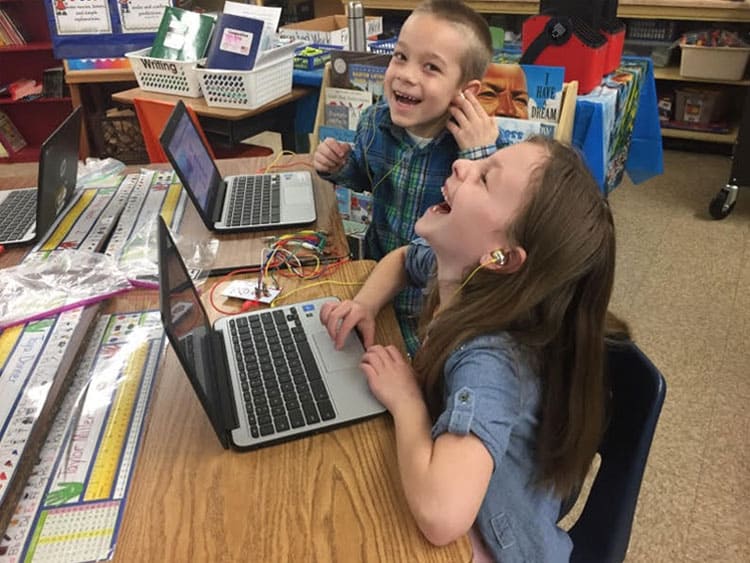Over the last three years, the Virginia K-12 Learning Infrastructure Program (KLIP) has helped dozens of schools increase their access to affordable, high-speed Internet. The Virginia Department of Education’s Learning Infrastructure Coordinator, Susan Clair, spearheads the effort to ensure school leaders are aware of the E-rate program, funding, tools and resources needed for a successful broadband upgrade.
In this Q&A, our state partner Susan (SC) interviews Director of Technology Darrell Hatfield (DH) of Orange County Public Schools about his legacy project to bring fiber to his school division and local community by utilizing federal and state E-rate funding.
SC: What are the demographics of your school district?
DH: Orange County Public Schools is classified as rural; [it] has two small towns and lots of farms. We have nine schools total and approximately 4,800 students. Over the last 10 years, we’ve seen a large growth in student population in Orange County.
SC: What was your motivation and vision for getting fiber infrastructure to your schools?
DH: With our increase in student population, we’ve had more kids and more teachers wanting to use resources in the classroom, for which we needed more bandwidth. Our Superintendent and I believe that the instruction has to drive the technology. We’re not going to do 1:1 [devices in the classroom] until there is an instructional need for that. I’m trying to get teachers to get there so they can use Discovery Education, IXL, Youtube Videos and more. We recently went Google two years ago and see a big increase in bandwidth from that. We currently have video conferencing, but it’s a little choppy due to bandwidth. We were looking to get more robust video conferencing. Once we do go 1:1 and once we get the network in, then everything is opened up.
My goal is to support what the teachers want to do. We’re doing everything in our power to put the devices in their hands to drive learning.
SC: What steps did you take to bring in other stakeholders?
DH: I discussed our fiber upgrade project with our Superintendent Brenda Tanner, who was 100% on board. Our school board said “any time we can get free money to boost our infrastructure, we’re all in for it.” Then I went to our County Government because I knew funds were limited, so I asked, “If we can do this, and you can join in with us to do your own fiber, would you be interested in helping us out?” And they said “Absolutely.” The Government agreed to cover cost percentages that weren’t covered by E-rate and the Virginia Public School Authority (VPSA). They run their own fiber in there with us.
SC: It sounds like everyone worked together to make this happen. Did you utilize any other resources or partners in Virginia?
DH: We couldn’t have done this project without Bruno, our E-rate consultant. The K-12 Learning Infrastructure Program listserv emails are also relevant for things that are going on and triggered me to contact Bruno for support.
I also used Compare & Connect K-12 to see what other school districts were paying for their broadband: who leased fiber, and from which service providers. Part of the original decision was there was no way we’d be able to do things on our own, so [affordability] was a catalyst to decide to do this.
SC: Why did you want to do a self-provisioned fiber upgrade?
DH: Financially, there was no other way to get there than to self-provision our fiber. When this opportunity came, we realized it would be able to 1) Eliminate the monthly cost we’d be needing to pay and 2) Give us unlimited bandwidth – we would be where we need to be for the foreseeable future and future-proof our Wide Area Network (WAN). I knew E-rate funding and state match would reduce costs, and with County Government on board, we’re not really spending any money on this project.
I kept telling [stakeholders]: “You don’t know what the future is going to hold. The cost of fiber is cheaper than it’s ever been.”
SC: What were some of your biggest challenges with getting fiber to your division, and what advice do you have to other technology directors in similar situations?
DH: The hardest part of this was the frustration of dealing with USAC’s questions, rule changes, and re-evaluations. My advice is to be patient, try to be understanding and leverage the support you can get. The undivided attention from our E-rate consultant Bruno was invaluable.
Susan: Have you gotten any feedback from your community about this fiber project?
Darrell: Yes, everyone we talk to says “Yes, this is a great thing for Orange County, thanks for this.” Our County Administrator says “This could be our legacy project”. It’s seen as a huge win for a lot of people in Orange County.
Cost breakdown of Orange County Public Schools’ fiber project:
Original Proposal: $1,335,825.90
E-rate Committed Funding Amount: $1,005,402.38
10% Virginia State Match: $133,582.59
Funding by County Government (remaining amount): $196,840.93
→ District out-of-pocket costs: $0
*Note: The Q&A content of this blog has been edited for clarity.
Read more about OCPS’s project in this Press Release and visit the K-12 Learning Infrastructure Program website to learn about Virginia’s broadband initiative.




